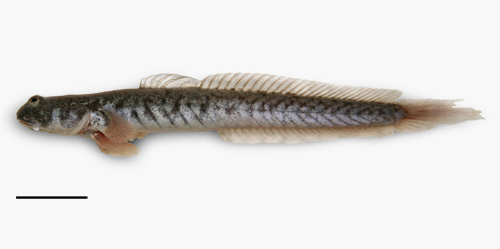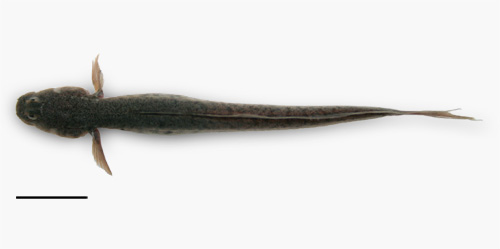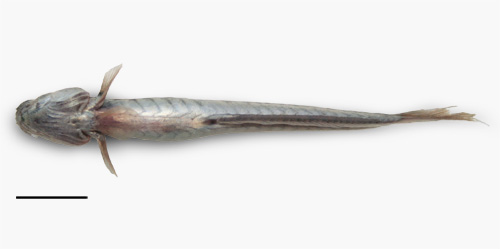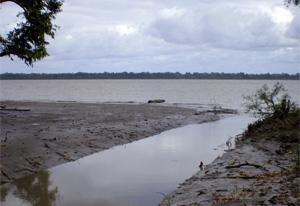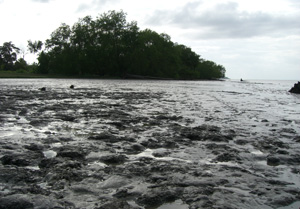Common names:
Australia |
English |
slender mudskipper |
China |
Chinese Mandarin |
柴帕钝牙虾虎鱼, 柴帕鈍牙鰕虎魚 (chai pa dun ya xia hu yu - Chaipa’s blunt-teethed goby) |
Italy |
Italian |
saltafango di Zappa* |
United Kingdom |
English |
New Guinea slender mudskipper |
* proposed name
|
|
|
Synonyms:
Etymology:
the generic name is entitled to Frank Zappa, popular US singer (Murdy, 1989)
'confluentus' means 'connected' in Latin, which refers to the connection between the dorsal and anal
fins to the caudal fin (Murdy, 1989)
|
Maximum recorded length:
60 mm SL (Polgar et al., 2010)
Live colouration (Polgar et al., 2010):
ground colour dark grey to greenish dorsally, pale grey laterally and ventrally; pigmentation absent around the anal fin; irregular dark blotches and oblique dark bars on sides, with a chevron-like dark pattern which delineates the lateral myotomes; dorsal fins, anal and caudal fins hyaline; pectoral and pelvic fins with reddish rays
Colouration on preservation (Murdy, 1989; pers. obs.: Papua New Guinea):
ground colour dark grey, whitish ventrally; fins hyaline
Diagnosis (Murdy, 1989):
total D2 elements 27-30. dorsal fins connected by membrane; D2 connected by membrane to the caudal fin; posterior interorbital pore present.
The genus is characterised by the first spinous dorsal fin pterygiophore which is bent posteriorly at a point three quarters along its length to
extend horizontally over tip of fourth neural spine (see drawing)
Diet:
no published study is available; while out of water, the feeding behaviour is very similar to that one of other phytoplanktivorous species, such as Pseudapocryptes elongatus and Boleophthalmus spp.
(pers. obs.)
Reproduction:
no published study is available
|
|
Ecological notes (Polgar et al., 2010):
found only in freshwater, in big numbers on mud river banks and open mudflats at low tide; it digs shallow burrows in the mud, actively feeding and interacting on the exposed substrate.
left: mud creek banks in front of Sturt Is.; fish are feeding at the water edge; lower Fly river, Papua New Guinea.
right:
open mudflat: here huge numbers of this species feed nearby tide pools; Tapila, lower Fly river, Papua New Guinea.
(Photos by G. Polgar, Papua New Guinea, 2007)
|
|
|
|
|
Distribution:
known only from Papua New Guinea, from the lower tracts of the Fly, Ramu and Bintuni rivers (Allen, 1991; Murdy, 1989; Roberts, 1978); type locality: Maidiri, Fly River, Papua New Guinea (Murdy, 1989)
|
Photographs of Zappa confluentus:
|
|
A: old photo of Z. confluentus, from its original description (Fly River, Papua New Guinea: Roberts, 1978, reproduced also in Murdy, 1989)*; B: an individual hidding inside a burrow (Sturt Is., Fly River, Papua New Guinea: photo G. Polgar, 2007); C: an exposed burrow reveals its superficial structure (Sturt Is., Fly River, Papua New Guinea: photo G. Polgar, 2007); D-F: close-ups (Sturt Is., Fly River, Papua New Guinea: photo G. Polgar, 2007); G-H: the main openings of their burrows: note the sub-horizontal inclination of tunnels (Sturt Is., lower Fly River, Papua New Guinea: photo G. Polgar, 2007); I: another close-up (Tapila, lower Fly River, Papua New Guinea: photo G. Polgar, 2007); J: a specimen inside a plastic bag (Fly River, Papua New Guinea: photo G. Polgar, 2007); K: an individual half-buried into mud in aquarium: note how pectoral fins let water pass from the gill slits to the outside (Fly River, Papua New Guinea: photo G. Polgar, 2007); L: a specimen in aquarium while it digs its burrow (Fly River, Papua New Guinea: photo G. Polgar, 2007).
|
Drawings of Zappa confluentus:
left: lateral view of the interdigitation between the first spinous dorsal fin pterygiophore and the fourth neural spine
(modified from Murdy, 1989)*; right: cephalic
sensory and nasal pores of Z. confluentus: an= anterior nostril; ao= anterior oculoscapular canal pore;
pio= posterior interorbital pore; pn= posterior nostril (modified from
Murdy, 1989)* - * with permission
|




